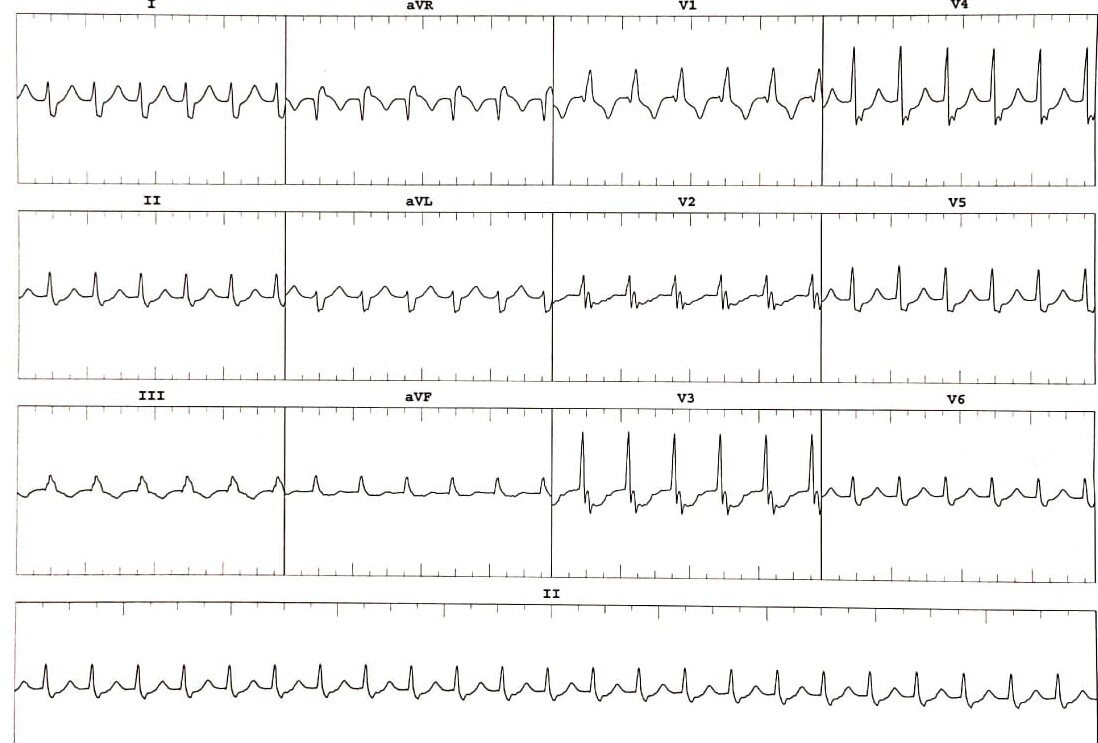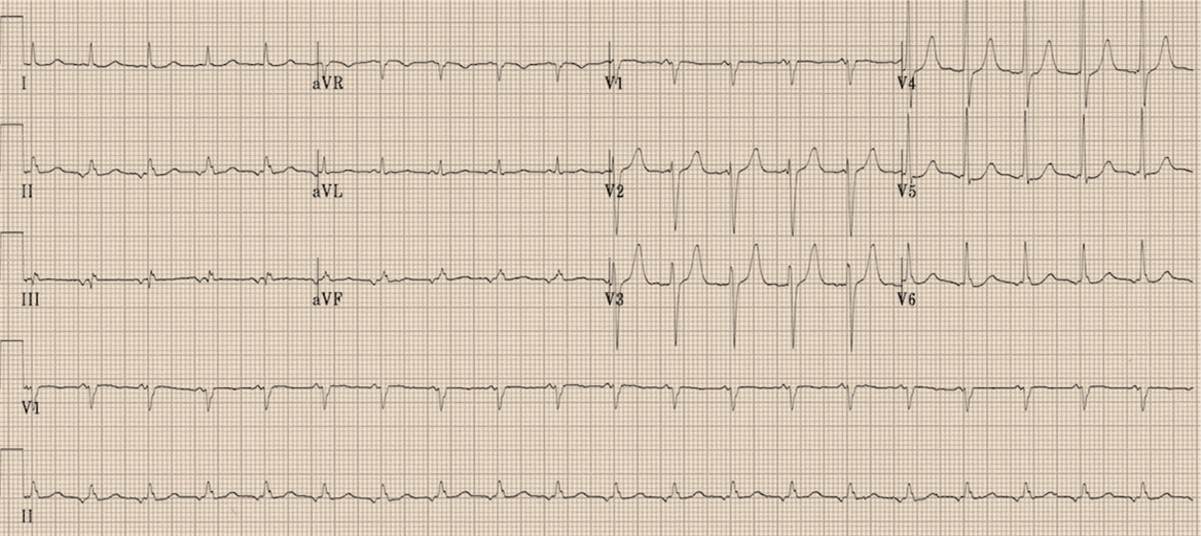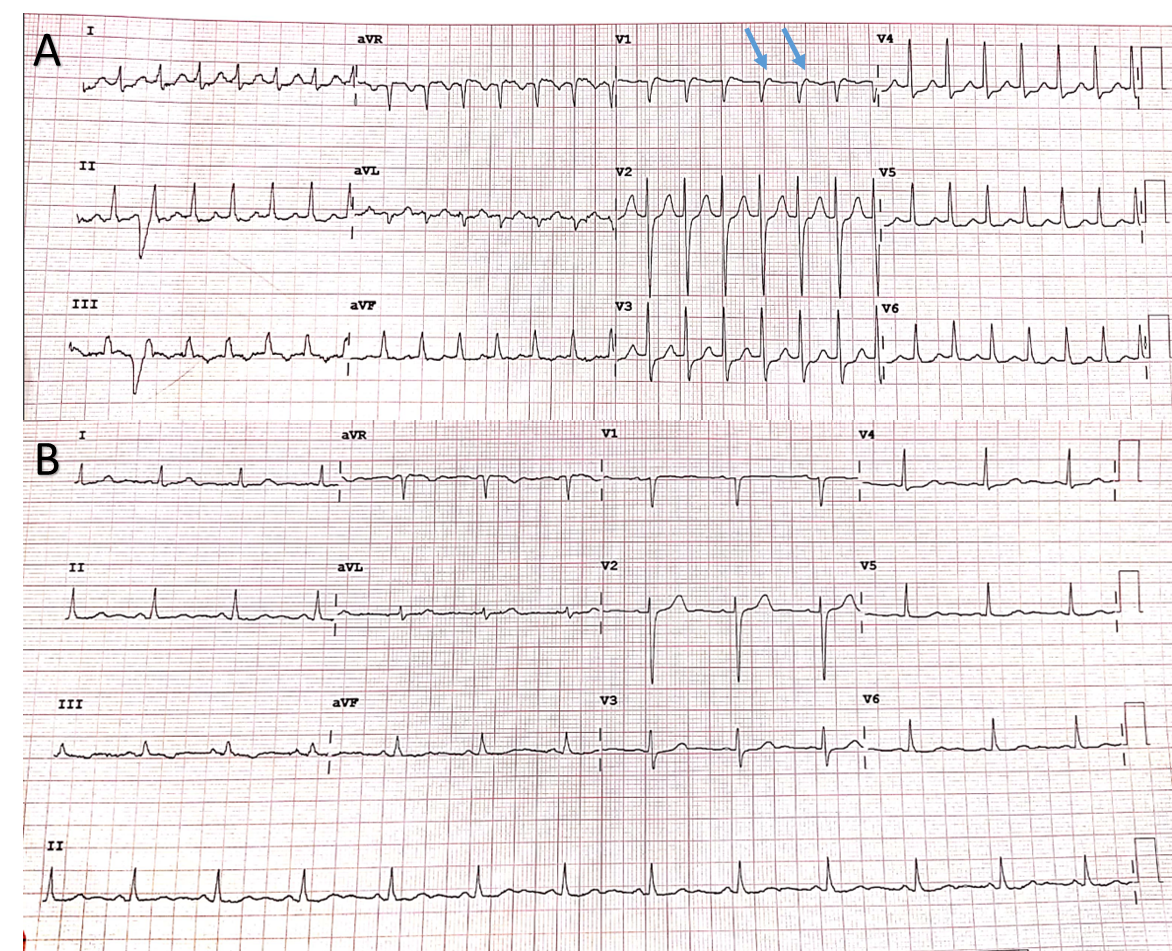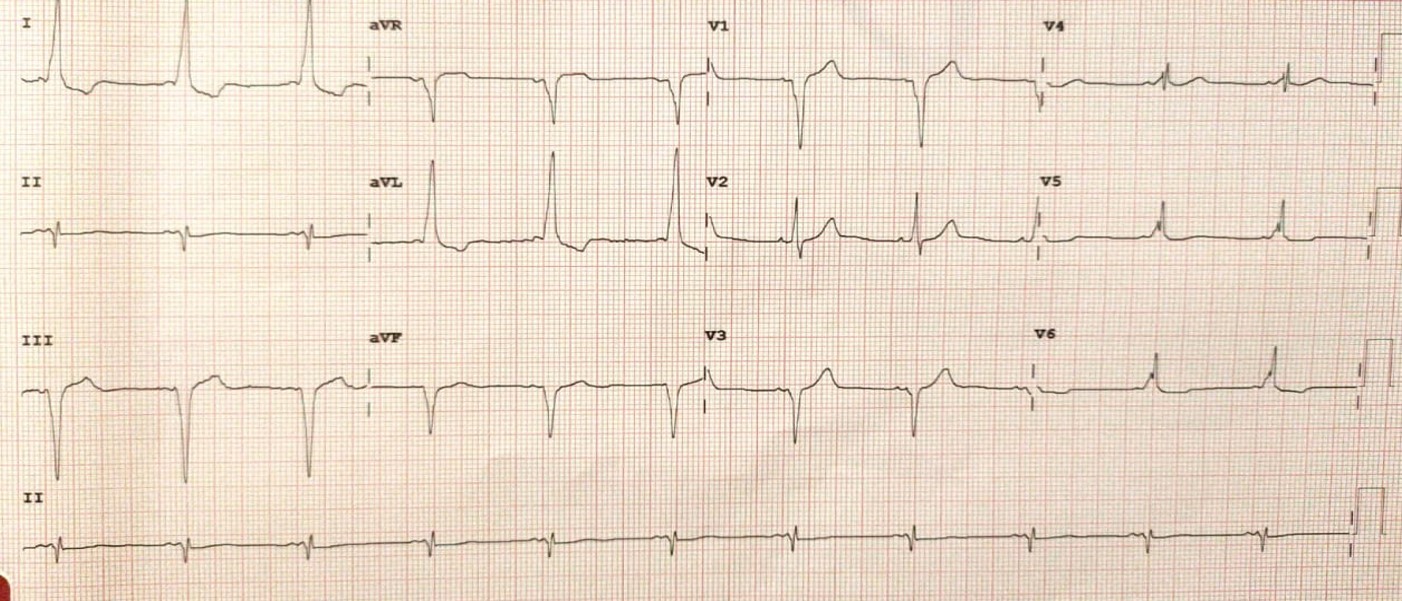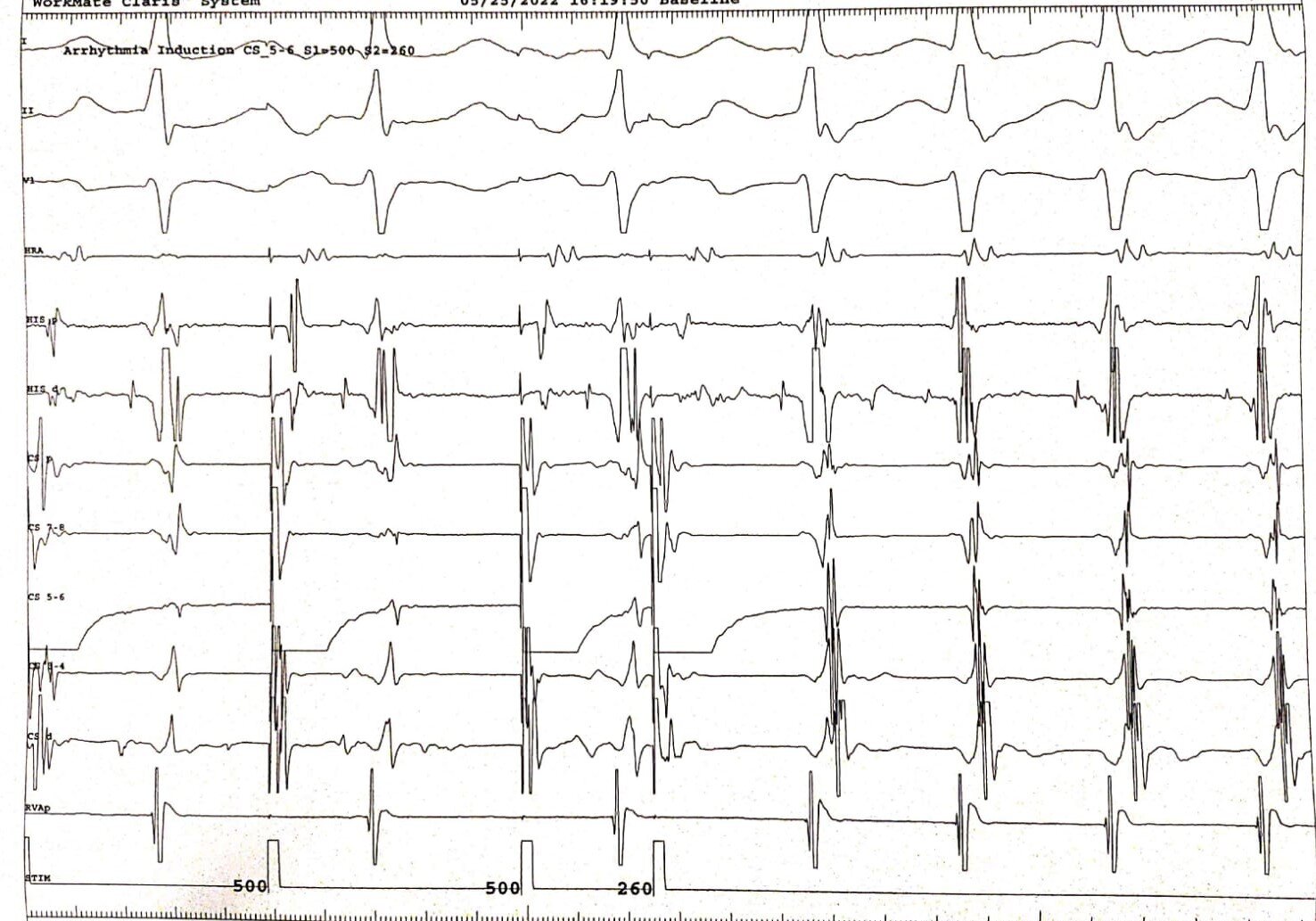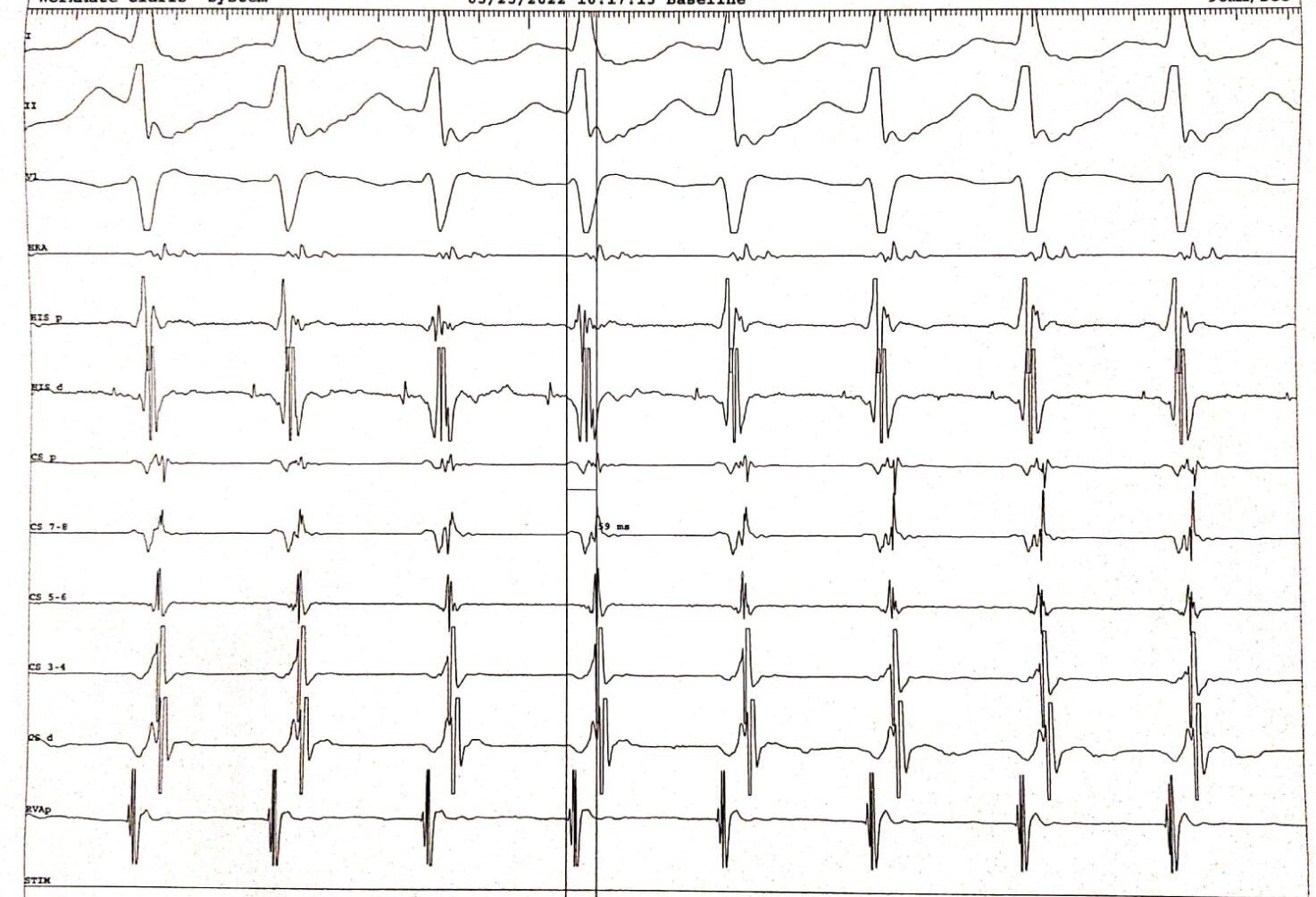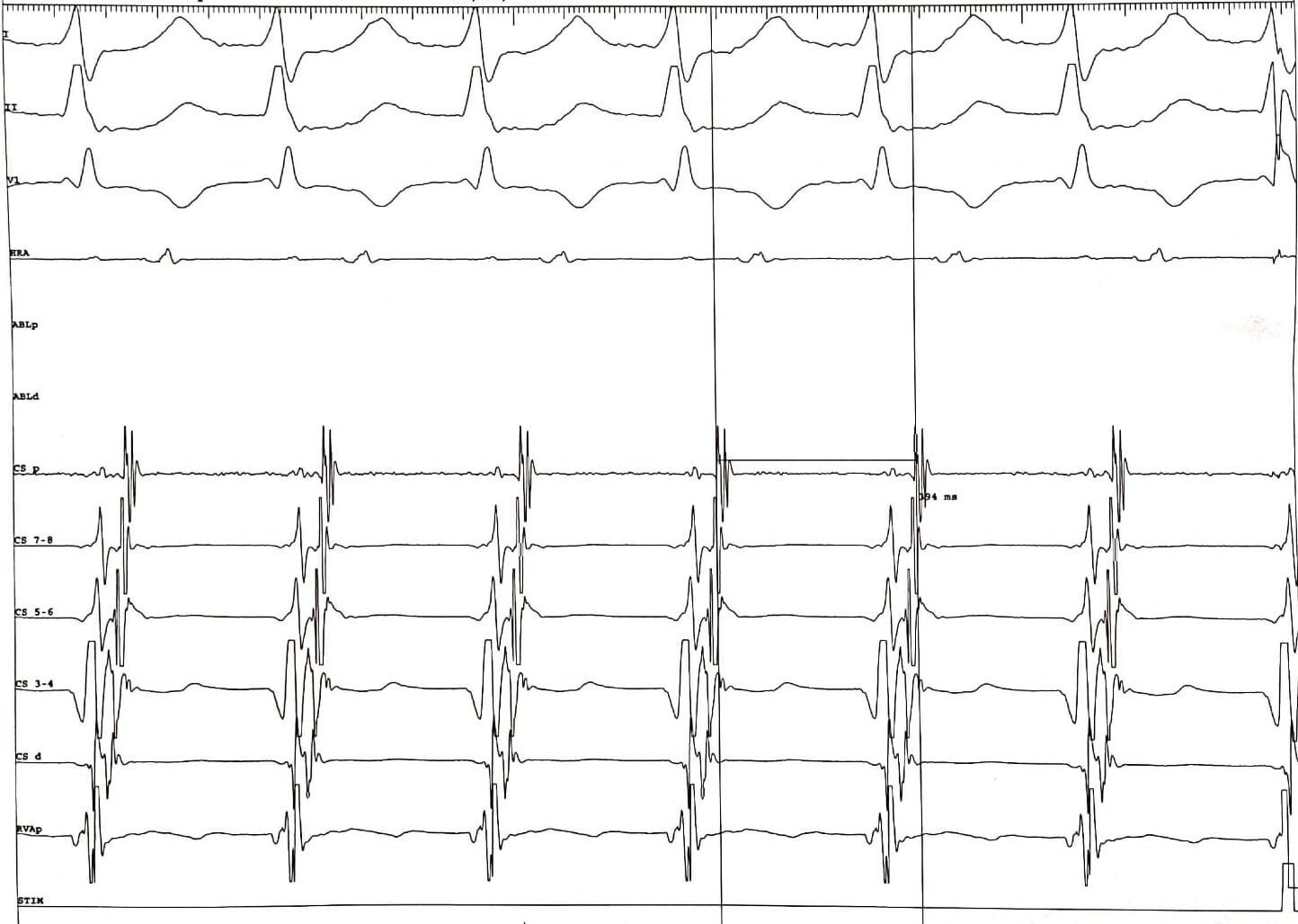[1]
Page RL, Joglar JA, Caldwell MA, Calkins H, Conti JB, Deal BJ, Estes NA III, Field ME, Goldberger ZD, Hammill SC, Indik JH, Lindsay BD, Olshansky B, Russo AM, Shen WK, Tracy CM, Al-Khatib SM. 2015 ACC/AHA/HRS guideline for the management of adult patients with supraventricular tachycardia: A Report of the American College of Cardiology/American Heart Association Task Force on Clinical Practice Guidelines and the Heart Rhythm Society. Heart rhythm. 2016 Apr:13(4):e136-221. doi: 10.1016/j.hrthm.2015.09.019. Epub 2015 Sep 25 [PubMed PMID: 26409100]
[2]
Orejarena LA, Vidaillet H Jr, DeStefano F, Nordstrom DL, Vierkant RA, Smith PN, Hayes JJ. Paroxysmal supraventricular tachycardia in the general population. Journal of the American College of Cardiology. 1998 Jan:31(1):150-7 [PubMed PMID: 9426034]
[3]
Yetkin E, Ozturk S, Cuglan B, Turhan H. Clinical presentation of paroxysmal supraventricular tachycardia: evaluation of usual and unusual symptoms. Cardiovascular endocrinology & metabolism. 2020 Dec:9(4):153-158. doi: 10.1097/XCE.0000000000000208. Epub 2020 May 15 [PubMed PMID: 33225230]
[4]
Kadish A, Passman R. Mechanisms and management of paroxysmal supraventricular tachycardia. Cardiology in review. 1999 Sep-Oct:7(5):254-64 [PubMed PMID: 11208235]
[5]
Ozturk S, Turhan H, Yetkin E. Asthma-like attacks terminated by slow pathway ablation. Annals of thoracic medicine. 2017 Apr-Jun:12(2):127-128. doi: 10.4103/1817-1737.203739. Epub [PubMed PMID: 28469725]
[6]
Yetkin E, Kaleagzi FC. Recovery of absence seizure-like symptoms in a patient after slow pathway radiofrequency ablation. International journal of cardiology. 2015 Mar 1:182():44-5. doi: 10.1016/j.ijcard.2014.12.111. Epub 2014 Dec 27 [PubMed PMID: 25576718]
[7]
Yetkin G, Ozturk S, Yetkin E. Chilling-Like Attacks Terminated by Slow Pathway Ablation. Current cardiology reviews. 2020:16(4):338-340. doi: 10.2174/1573403X15666191212100050. Epub [PubMed PMID: 31830887]
[8]
Kara M, Korkmaz A, Ozeke O, Cay S, Ozcan F, Topaloglu S, Aras D. Manifest 1:2 tachycardia or atrioventricular nodal reentrant tachycardia with complete ventriculoatrial dissociation. Journal of cardiovascular electrophysiology. 2020 Jun:31(6):1563-1564. doi: 10.1111/jce.14465. Epub 2020 Apr 7 [PubMed PMID: 32255532]
[9]
Buttà C, Tuttolomondo A, Giarrusso L, Pinto A. Electrocardiographic diagnosis of atrial tachycardia: classification, P-wave morphology, and differential diagnosis with other supraventricular tachycardias. Annals of noninvasive electrocardiology : the official journal of the International Society for Holter and Noninvasive Electrocardiology, Inc. 2015 Jul:20(4):314-27. doi: 10.1111/anec.12246. Epub 2014 Dec 22 [PubMed PMID: 25530184]
[10]
Ahmad F, Abu Sneineh M, Patel RS, Rohit Reddy S, Llukmani A, Hashim A, Haddad DR, Gordon DK. In The Line of Treatment: A Systematic Review of Paroxysmal Supraventricular Tachycardia. Cureus. 2021 Jun:13(6):e15502. doi: 10.7759/cureus.15502. Epub 2021 Jun 7 [PubMed PMID: 34268033]
[11]
Brachmann J, Lewalter T, Kuck KH, Andresen D, Willems S, Spitzer SG, Straube F, Schumacher B, Eckardt L, Danilovic D, Thomas D, Hochadel M, Senges J. Long-term symptom improvement and patient satisfaction following catheter ablation of supraventricular tachycardia: insights from the German ablation registry. European heart journal. 2017 May 1:38(17):1317-1326. doi: 10.1093/eurheartj/ehx101. Epub [PubMed PMID: 28329395]
[12]
Doevendans PA, Wellens HJ. Wolff-Parkinson-white syndrome: a genetic disease? Circulation. 2001 Dec 18:104(25):3014-6 [PubMed PMID: 11748090]
[13]
Wu J, Wu J, Olgin J, Miller JM, Zipes DP. Mechanisms underlying the reentrant circuit of atrioventricular nodal reentrant tachycardia in isolated canine atrioventricular nodal preparation using optical mapping. Circulation research. 2001 Jun 8:88(11):1189-95 [PubMed PMID: 11397786]
[15]
Katritsis DG, Camm AJ. Atrioventricular nodal reentrant tachycardia. Circulation. 2010 Aug 24:122(8):831-40. doi: 10.1161/CIRCULATIONAHA.110.936591. Epub [PubMed PMID: 20733110]
[17]
Subhani F, Ahmed I, Manji AA, Saeed Y. Atrial Tachycardia Associated With a Tachycardia-Induced Cardiomyopathy in a Patient With Systemic Lupus Erythematosus. Cureus. 2020 Nov 22:12(11):e11626. doi: 10.7759/cureus.11626. Epub 2020 Nov 22 [PubMed PMID: 33376640]
[18]
Porter MJ, Morton JB, Denman R, Lin AC, Tierney S, Santucci PA, Cai JJ, Madsen N, Wilber DJ. Influence of age and gender on the mechanism of supraventricular tachycardia. Heart rhythm. 2004 Oct:1(4):393-6 [PubMed PMID: 15851189]
[19]
Tada H, Oral H, Greenstein R, Pelosi F Jr, Knight BP, Strickberger SA, Morady F. Analysis of age of onset of accessory pathway-mediated tachycardia in men and women. The American journal of cardiology. 2002 Feb 15:89(4):470-1 [PubMed PMID: 11835934]
[20]
Liuba I, Jönsson A, Säfström K, Walfridsson H. Gender-related differences in patients with atrioventricular nodal reentry tachycardia. The American journal of cardiology. 2006 Feb 1:97(3):384-8 [PubMed PMID: 16442401]
[21]
Kanjwal K, Kanjwal S, Ruzieh M. Atrioventricular Nodal Reentrant Tachycardia in Very Elderly Patients: A Single-center Experience. The Journal of innovations in cardiac rhythm management. 2020 Feb:11(2):3990-3995. doi: 10.19102/icrm.2020.110202. Epub 2020 Feb 15 [PubMed PMID: 32368371]
[22]
Fitzsimmons PJ, McWhirter PD, Peterson DW, Kruyer WB. The natural history of Wolff-Parkinson-White syndrome in 228 military aviators: a long-term follow-up of 22 years. American heart journal. 2001 Sep:142(3):530-6 [PubMed PMID: 11526369]
[23]
Poutiainen AM, Koistinen MJ, Airaksinen KE, Hartikainen EK, Kettunen RV, Karjalainen JE, Huikuri HV. Prevalence and natural course of ectopic atrial tachycardia. European heart journal. 1999 May:20(9):694-700 [PubMed PMID: 10208790]
[24]
Steinbeck G, Hoffmann E. 'True' atrial tachycardia. European heart journal. 1998 May:19 Suppl E():E10-2, E48-9 [PubMed PMID: 9717019]
[25]
Xie B, Thakur RK, Shah CP, Hoon VK. Clinical differentiation of narrow QRS complex tachycardias. Emergency medicine clinics of North America. 1998 May:16(2):295-330 [PubMed PMID: 9621846]
[26]
Krahn AD, Yee R, Klein GJ, Morillo C. Inappropriate sinus tachycardia: evaluation and therapy. Journal of cardiovascular electrophysiology. 1995 Dec:6(12):1124-8 [PubMed PMID: 8720214]
[27]
Brugada P, Wellens HJ. The role of triggered activity in clinical ventricular arrhythmias. Pacing and clinical electrophysiology : PACE. 1984 Mar:7(2):260-71 [PubMed PMID: 6200854]
[28]
Tai CT, Chen SA, Chiang CE, Lee SH, Wen ZC, Chiou CW, Ueng KC, Chen YJ, Yu WC, Huang JL, Chang MS. Complex electrophysiological characteristics in atrioventricular nodal reentrant tachycardia with continuous atrioventricular node function curves. Circulation. 1997 Jun 3:95(11):2541-7 [PubMed PMID: 9184584]
[29]
Katritsis DG, Josephson ME. Classification, Electrophysiological Features and Therapy of Atrioventricular Nodal Reentrant Tachycardia. Arrhythmia & electrophysiology review. 2016 Aug:5(2):130-5. doi: 10.15420/AER.2016.18.2. Epub [PubMed PMID: 27617092]
[30]
Obel OA, Camm AJ. Accessory pathway reciprocating tachycardia. European heart journal. 1998 May:19 Suppl E():E13-24, E50-1 [PubMed PMID: 9717020]
[31]
Kulig J, Koplan BA. Cardiology patient page. Wolff-Parkinson-White syndrome and accessory pathways. Circulation. 2010 Oct 12:122(15):e480-3. doi: 10.1161/CIRCULATIONAHA.109.929372. Epub [PubMed PMID: 20937983]
[32]
Markowitz SM, Thomas G, Liu CF, Cheung JW, Ip JE, Lerman BB. Atrial Tachycardias and Atypical Atrial Flutters: Mechanisms and Approaches to Ablation. Arrhythmia & electrophysiology review. 2019 May:8(2):131-137. doi: 10.15420/aer.2019.17.2. Epub [PubMed PMID: 31114688]
[33]
Link MS. Clinical practice. Evaluation and initial treatment of supraventricular tachycardia. The New England journal of medicine. 2012 Oct 11:367(15):1438-48. doi: 10.1056/NEJMcp1111259. Epub [PubMed PMID: 23050527]
[34]
Fox DJ, Tischenko A, Krahn AD, Skanes AC, Gula LJ, Yee RK, Klein GJ. Supraventricular tachycardia: diagnosis and management. Mayo Clinic proceedings. 2008 Dec:83(12):1400-11. doi: 10.1016/S0025-6196(11)60791-X. Epub [PubMed PMID: 19046562]
[35]
Ganz LI, Friedman PL. Supraventricular tachycardia. The New England journal of medicine. 1995 Jan 19:332(3):162-73 [PubMed PMID: 7800009]
[36]
Bibas L, Levi M, Essebag V. Diagnosis and management of supraventricular tachycardias. CMAJ : Canadian Medical Association journal = journal de l'Association medicale canadienne. 2016 Dec 6:188(17-18):E466-E473. doi: 10.1503/cmaj.160079. Epub 2016 Oct 24 [PubMed PMID: 27777258]
[37]
Abedin Z. Differential diagnosis of wide QRS tachycardia: A review. Journal of arrhythmia. 2021 Oct:37(5):1162-1172. doi: 10.1002/joa3.12599. Epub 2021 Aug 9 [PubMed PMID: 34621415]
[38]
Josephson ME, Wellens HJ. Electrophysiologic evaluation of supraventricular tachycardia. Cardiology clinics. 1997 Nov:15(4):567-86 [PubMed PMID: 9403161]
[39]
Obel OA, Camm AJ. Supraventricular tachycardia. ECG diagnosis and anatomy. European heart journal. 1997 May:18 Suppl C():C2-11 [PubMed PMID: 9152669]
[40]
Nasir M, Sturts A, Sturts A. Common Types of Supraventricular Tachycardia: Diagnosis and Management. American family physician. 2023 Jun:107(6):631-641 [PubMed PMID: 37327167]
[41]
Ip JE, Thomas G, Cheung JW, Liu CF, Markowitz SM, Lerman BB. Recognition of short RP atrial tachycardia due to intra-atrial conduction delay: utility of a septal AH/HA Ratio {1. Europace : European pacing, arrhythmias, and cardiac electrophysiology : journal of the working groups on cardiac pacing, arrhythmias, and cardiac cellular electrophysiology of the European Society of Cardiology. 2017 Nov 1:19(11):1780. doi: 10.1093/europace/eux105. Epub [PubMed PMID: 28575185]
[42]
Katritsis DG, Ellenbogen KA, Becker AE. Atrial activation during atrioventricular nodal reentrant tachycardia: studies on retrograde fast pathway conduction. Heart rhythm. 2006 Sep:3(9):993-1000 [PubMed PMID: 16945788]
[43]
Keating L, Morris FP, Brady WJ. Electrocardiographic features of Wolff-Parkinson-White syndrome. Emergency medicine journal : EMJ. 2003 Sep:20(5):491-3 [PubMed PMID: 12954704]
[44]
Cardona-Guarache R, Han FT, Nguyen DT, Chicos AB, Badhwar N, Knight BP, Johnson CJ, Heaven D, Scheinman MM. Ablation of Supraventricular Tachycardias From Concealed Left-Sided Nodoventricular and Nodofascicular Accessory Pathways. Circulation. Arrhythmia and electrophysiology. 2020 May:13(5):e007853. doi: 10.1161/CIRCEP.119.007853. Epub 2020 Apr 14 [PubMed PMID: 32286853]
[45]
Bagliani G, De Ponti R, Sciarra L, Zingarini G, Leonelli FM. Accessory Pathway-Mediated Tachycardias: Precision Electrocardiology Through Standard and Advanced Electrocardiogram Recording Techniques. Cardiac electrophysiology clinics. 2020 Dec:12(4):475-493. doi: 10.1016/j.ccep.2020.08.008. Epub 2020 Sep 30 [PubMed PMID: 33161997]
[46]
Kalbfleisch SJ, el-Atassi R, Calkins H, Langberg JJ, Morady F. Differentiation of paroxysmal narrow QRS complex tachycardias using the 12-lead electrocardiogram. Journal of the American College of Cardiology. 1993 Jan:21(1):85-9 [PubMed PMID: 8417081]
[47]
Steven D, Bonnemeier H, Deneke T, Estner HL, Kriatselis C, Kuniss M, Luik A, Neuberger HR, Shin DI, Sommer P, Tilz RR, Thomas D, von Bary C, Voss F, Eckardt L. [How to approach the patient with supraventricular tachycardia in the EP lab: A systematic overview]. Herzschrittmachertherapie & Elektrophysiologie. 2015 Jun:26(2):167-72. doi: 10.1007/s00399-015-0373-7. Epub 2015 Jun 2 [PubMed PMID: 26031513]
[48]
Knight BP, Ebinger M, Oral H, Kim MH, Sticherling C, Pelosi F, Michaud GF, Strickberger SA, Morady F. Diagnostic value of tachycardia features and pacing maneuvers during paroxysmal supraventricular tachycardia. Journal of the American College of Cardiology. 2000 Aug:36(2):574-82 [PubMed PMID: 10933374]
[49]
Veenhuyzen GD, Quinn FR, Wilton SB, Clegg R, Mitchell LB. Diagnostic pacing maneuvers for supraventricular tachycardia: part 1. Pacing and clinical electrophysiology : PACE. 2011 Jun:34(6):767-82. doi: 10.1111/j.1540-8159.2011.03076.x. Epub 2011 Mar 25 [PubMed PMID: 21438892]
[50]
Neumar RW, Otto CW, Link MS, Kronick SL, Shuster M, Callaway CW, Kudenchuk PJ, Ornato JP, McNally B, Silvers SM, Passman RS, White RD, Hess EP, Tang W, Davis D, Sinz E, Morrison LJ. Part 8: adult advanced cardiovascular life support: 2010 American Heart Association Guidelines for Cardiopulmonary Resuscitation and Emergency Cardiovascular Care. Circulation. 2010 Nov 2:122(18 Suppl 3):S729-67. doi: 10.1161/CIRCULATIONAHA.110.970988. Epub [PubMed PMID: 20956224]
[51]
DiMarco JP, Miles W, Akhtar M, Milstein S, Sharma AD, Platia E, McGovern B, Scheinman MM, Govier WC. Adenosine for paroxysmal supraventricular tachycardia: dose ranging and comparison with verapamil. Assessment in placebo-controlled, multicenter trials. The Adenosine for PSVT Study Group. Annals of internal medicine. 1990 Jul 15:113(2):104-10 [PubMed PMID: 2193560]
[52]
Madsen CD, Pointer JE, Lynch TG. A comparison of adenosine and verapamil for the treatment of supraventricular tachycardia in the prehospital setting. Annals of emergency medicine. 1995 May:25(5):649-55 [PubMed PMID: 7741343]
[54]
Stec S, Kryński T, Kułakowski P. Efficacy of low energy rectilinear biphasic cardioversion for regular atrial tachyarrhythmias. Cardiology journal. 2011:18(1):33-8 [PubMed PMID: 21305483]
[55]
Nakagawa H, Jackman WM. Catheter ablation of paroxysmal supraventricular tachycardia. Circulation. 2007 Nov 20:116(21):2465-78 [PubMed PMID: 18025404]
[56]
Page RL, Joglar JA, Caldwell MA, Calkins H, Conti JB, Deal BJ, Estes NAM 3rd, Field ME, Goldberger ZD, Hammill SC, Indik JH, Lindsay BD, Olshansky B, Russo AM, Shen WK, Tracy CM, Al-Khatib SM. 2015 ACC/AHA/HRS Guideline for the Management of Adult Patients With Supraventricular Tachycardia: A Report of the American College of Cardiology/American Heart Association Task Force on Clinical Practice Guidelines and the Heart Rhythm Society. Journal of the American College of Cardiology. 2016 Apr 5:67(13):e27-e115. doi: 10.1016/j.jacc.2015.08.856. Epub 2015 Sep 24 [PubMed PMID: 26409259]
[57]
Page RL, Joglar JA, Caldwell MA, Calkins H, Conti JB, Deal BJ, Estes NAM 3rd, Field ME, Goldberger ZD, Hammill SC, Indik JH, Lindsay BD, Olshansky B, Russo AM, Shen WK, Tracy CM, Al-Khatib SM. 2015 ACC/AHA/HRS Guideline for the Management of Adult Patients With Supraventricular Tachycardia: Executive Summary: A Report of the American College of Cardiology/American Heart Association Task Force on Clinical Practice Guidelines and the Heart Rhythm Society. Journal of the American College of Cardiology. 2016 Apr 5:67(13):1575-1623. doi: 10.1016/j.jacc.2015.09.019. Epub 2015 Sep 24 [PubMed PMID: 26409258]
[58]
Bathina MN, Mickelsen S, Brooks C, Jaramillo J, Hepton T, Kusumoto FM. Radiofrequency catheter ablation versus medical therapy for initial treatment of supraventricular tachycardia and its impact on quality of life and healthcare costs. The American journal of cardiology. 1998 Sep 1:82(5):589-93 [PubMed PMID: 9732885]
[59]
Harper RW, Whitford E, Middlebrook K, Federman J, Anderson S, Pitt A. Effects of verapamil on the electrophysiologic properties of the accessory pathway in patients with the Wolff-Parkinson-White syndrome. The American journal of cardiology. 1982 Dec:50(6):1323-30 [PubMed PMID: 7148709]
[60]
Katritsis DG, Josephson ME. Differential diagnosis of regular, narrow-QRS tachycardias. Heart rhythm. 2015 Jul:12(7):1667-76. doi: 10.1016/j.hrthm.2015.03.046. Epub 2015 Mar 28 [PubMed PMID: 25828600]
[61]
Meissner A, Stifoudi I, Weismüller P, Schrage MO, Maagh P, Christ M, Butz T, Trappe HJ, Plehn G. Sustained high quality of life in a 5-year long term follow-up after successful ablation for supra-ventricular tachycardia. results from a large retrospective patient cohort. International journal of medical sciences. 2009:6(1):28-36 [PubMed PMID: 19158961]
[62]
Laaouaj J, Jacques F, O'Hara G, Champagne J, Sarrazin JF, Nault I, Philippon F. Wolff-Parkinson-White as a bystander in a patient with aborted sudden cardiac death. HeartRhythm case reports. 2016 Sep:2(5):399-403. doi: 10.1016/j.hrcr.2016.05.004. Epub 2016 May 13 [PubMed PMID: 28491720]
[63]
Obeyesekere M, Gula LJ, Skanes AC, Leong-Sit P, Klein GJ. Risk of sudden death in Wolff-Parkinson-White syndrome: how high is the risk? Circulation. 2012 Feb 7:125(5):659-60. doi: 10.1161/CIRCULATIONAHA.111.085159. Epub 2012 Jan 3 [PubMed PMID: 22215858]
[64]
Meti N, Mongeon FP, Guerra PG, O'Meara E, Khairy P. Incessant atrioventricular nodal reentrant tachycardia with tachycardia-induced cardiomyopathy, biventricular thrombosis, and pulmonary emboli. HeartRhythm case reports. 2016 Mar:2(2):142-145. doi: 10.1016/j.hrcr.2015.11.012. Epub 2016 Jan 15 [PubMed PMID: 28491653]
[65]
Moondra V, Sangha R, Greenberg ML. Spontaneous deterioration of atrioventricular nodal reentrant tachycardia to polymorphic ventricular tachycardia in the absence of heart disease. Pacing and clinical electrophysiology : PACE. 2011 Feb:34(2):e14-7. doi: 10.1111/j.1540-8159.2010.02737.x. Epub [PubMed PMID: 20345622]

